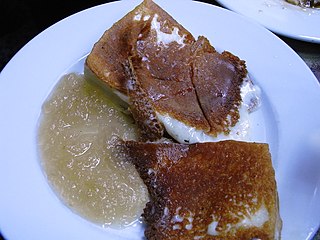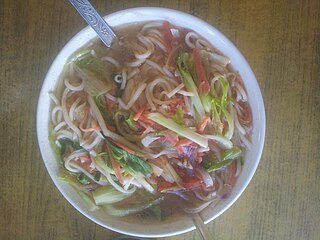Related Research Articles

Mizithra or myzithra is a Greek whey cheese or mixed milk-whey cheese from sheep or goats, or both. It is sold both as a fresh cheese, similar to Italian ricotta, and as a salt-dried grating cheese, similar to Italian ricotta salata. The ratio of milk to whey is usually 7 to 3.

Tsampa or Tsamba is a Tibetan and Himalayan staple foodstuff, it is also prominent in parts of northern Nepal. It is a glutinous meal made from roasted flour, usually barley flour and sometimes also wheat flour and flour prepared from tree peony seeds. It is usually mixed with the Tibetan butter tea. It is also eaten in Turkestan and Mongolia, where it is known as zamba.

Shanklish, also known as chancliche, shinklish, shankleesh, sorke, sürke, or eddesh, is a type of cow or sheep milk cheese in Levantine cuisine.

Anthotyros is a traditional fresh cheese. There are dry Anthotyros and fresh Anthotyros. Dry Anthotyros is a matured cheese similar to Mizithra. Anthotyros is made with milk and whey from sheep or goats, sometimes in combination. The ratio of milk to whey usually is 9-to-1. It is commonly a truncated cone, but when shipped in containers may be crumbled, as it is removed. It may be unpasteurized, where law allows.

Majorero is a goat milk cheese from Spain. Similar to Manchego, this firm cheese has a milky, nutty flavour that goes well with various pear products. It is pale white in colour, and comes in large wheels. Currently, it is protected under European Law with Protected Designation of Origin (PDO) status.

Chhurpi, otherwise known as durkha and chogo/chugo, is a traditional cheese consumed in Nepal and Bhutan. The two varieties of chhurpi are a soft variety and a very hard variety. Chhurpi is considered one of the hardest cheeses in the world.

Tibetan cuisine includes the culinary traditions and practices of the Tibetan people in the Tibet region. The cuisine reflects the Tibetan landscape of mountains and plateaus and includes influences from neighbors. It is known for its use of noodles, goat, yak, mutton, dumplings, cheese, butter, yogurt, and soups. Vegetarianism has been debated by religious practitioners since the 11th century but is not prevalent due to the difficulty of growing vegetables, and cultural traditions promoting consumption of meat.

A staple of Bhutanese cuisine is Bhutanese red rice, which is like brown rice in texture, but has a nutty taste. It is the only variety of rice that grows at high altitudes. Other staples include buckwheat and increasingly maize.

Tibetan cheese is a food staple in Tibetan cuisine. Tibetan cheeses include soft cheese curds resembling cottage cheese made from buttermilk called chura loenpa. Hard cheese is called chura kampo. Extra hard cheese, made from solidified yogurt, is called chhurpi, and is also found in Sikkim and Nepal. Another type of cheese called shosha or churul, with a flavor said to resemble Limburger, is made from cream and the skin of milk.
Flower of Rajya is a firm yak's-milk cheese made in Nepal by Tibetan nomads in collaboration with the Trace Foundation. Milk is heated and ripened in big copper vats, curdled, drained and molded into 10–12 lb (4.5–5.4 kg) wheels. The cheese is dry-cured in Tibetan red salt, aged, then wrapped in scarves and packed in bamboo baskets.
Chura loenpa is a Tibetan cheese important within the cuisine of Tibet. It is a soft cheese, similar to cottage cheese, made from the curds that are left over from boiling buttermilk.

Sudanese cuisine is greatly affected by the historical cross-cultural influences of Arab, Nubian, Egyptian, Turkish, and Levantine cuisine in Sudan. Many Sudanese foods have been around for thousands of years. The most common meats eaten are lamb and beef, in accordance with the Muslim halal laws. Most meals are communal and often shared with family, neighbors, and guests, as part of Sudanese hospitality.
In Tibetan cuisine, Masen is a pastry, made with tsampa, dry cubic or curd cheese, yak butter, brown sugar and water.
In Tibetan cuisine, gyabrag is a pancake, made with barley flour, yak butter, dry cheese curds and sugar.
In Tibetan cuisine, gundain is a type of pastry made from barley grain and yeast, with tsampa, dry curd cheese, wild ginseng, and brown sugar. This pastry is often served during the Tibetan New Year and Losar as a starter.

Guthuk is a stew soup in Sherpa or Tibetan cuisine, made with various ingredients like beans, vegetables, meat, or left over harvested grains. It is eaten two days before Losar, the Bot or Tibetan New Year and is a variation on thukpa bhatuk. The Tibetan religious ceremony Gutor (དགུ་གཏོར), literally meaning 'offering of the 29th', is held on the 29th of the 12th Bot or Tibetan month, and is focused on driving out all negativity, including evil spirits and misfortunes of the past year, and starting the new year in a peaceful and auspicious way. It is made with barley and other ingredients.

Thukpa bhatuk is a common Tibetan cuisine noodle soup that includes small bhatsa noodles. This dish is a common soup made in the winter but is especially important for Tibetan New Year. On Nyi-Shu-Gu, the eve of Losar, the common Tibetan soup, thukpa bhatuk is made with special ingredients to form guthuk. Guthuk is then eaten on Losar to symbolise getting rid of negativities of the past year and invite positives into the new year.
Thue is a delicacy in Tibetan cuisine made with dri cheese, brown sugar and unsalted sweet cream butter. These ingredients are mixed together by hand into a smooth, slightly crumbly doughy mixture. It has a high butter content and is shaped in a thuedrom, a rectangular wooden frame about the size of a small brick. Thue is often topped with representations of the Moon and the Sun, carved out of butter while it is in a cold state. It is one of the few sweet Tibetan dishes and is eaten as a dessert on Losar and other special occasions like the Sho Dun Festival or on weddings.

Maithil cuisine, also known as Mithila cuisine, is a part of Indian and Nepalese cuisine. It is the traditional cooking style of Maithils residing in the Mithila region of the subcontinent.
References
- ↑ Dorfe, Rinjing (1985). Food in Tibetan Life. Banyan Press. p. 96. ISBN 9780907325260.